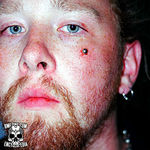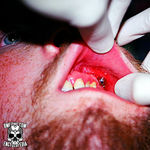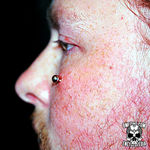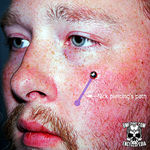Nick piercing
Visually (rather than culturally), this exotic piercing echoes the Renommier schmiss. The nick piercing, reminding one of the dueling scars popular among Austrians a hundred years before, is sort of like the opposite of the Vertical lowbret. It seeks to find one of the highest points on the inside of the mouth, and then travels straight up under the skin and musculature and exits underneath the orbit of the eye. As with most new piercings, the nick piercing gets its name from both the piercer (Nick Anzalone, Under the Needle, Seattle WA) and the first client (also called Nick) to publicize this piercing (June 2004).
The piercing is generally performed using an "L" shaped bar similar to a Surface bar, which is sized to fit the individual client's anatomy. Flexible jewelry such as Tygon is also an option. In either case, custom jewelry will be required, and sizing is important. Piercings like this can be quite uncomfortable during healing as you adapt to the restrictions and interactions that have with your musculature (the piercing lies roughly parallel to the quadratus labii superioris muscle fibers). In addition, risks of Gum erosion should be considered as well, depending on the placement of the inner bead.
Finally, it is very important to note that this exit point is often dangerously close to the infraorbital nerve with some placements, and this is one of the few piercings which could result in loss of feeling (including in the eye). You can feel for the infraorbital nerve by running your finger along the bottom of the eye orbit. Actually, you won't feel the nerve itself, but you'll feel the hole in your skull (the foramen) that the nerve exits from. If this nerve is severed, you'll have had an accidental Neurectomy which will result in permanent numbness in the upper cheek and area below the eye. Risk of damage to motor control nerves is extremely minimal though.



